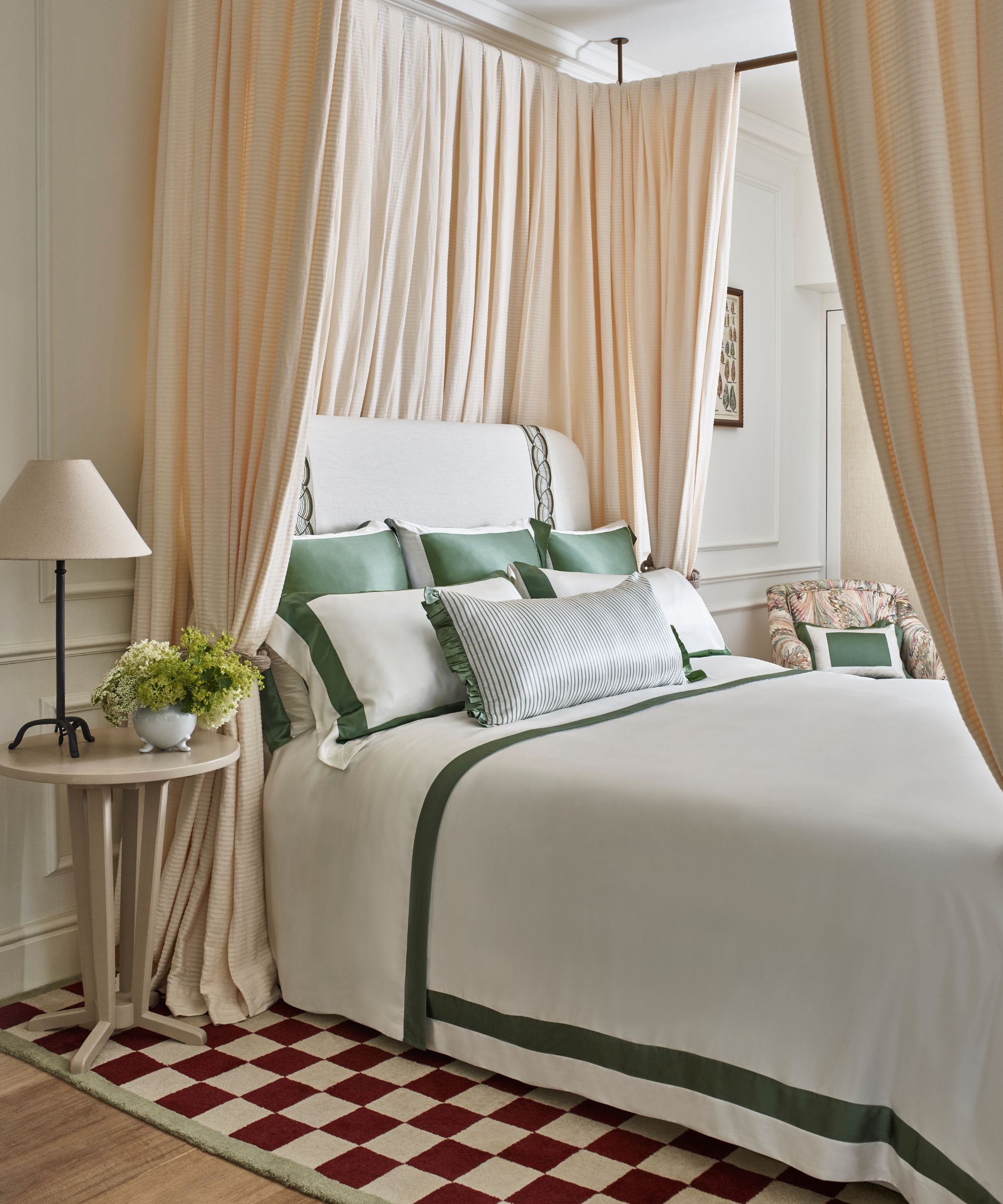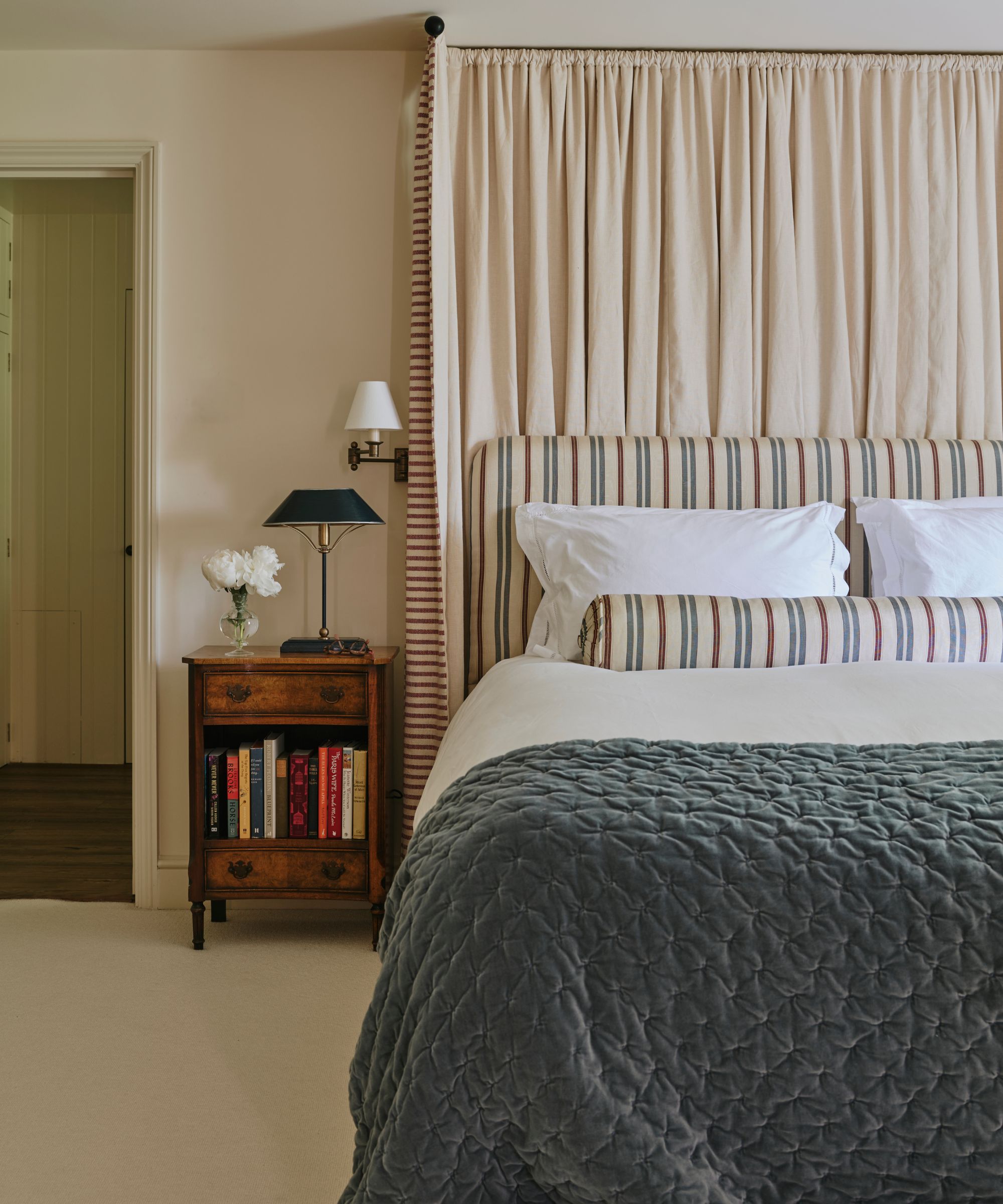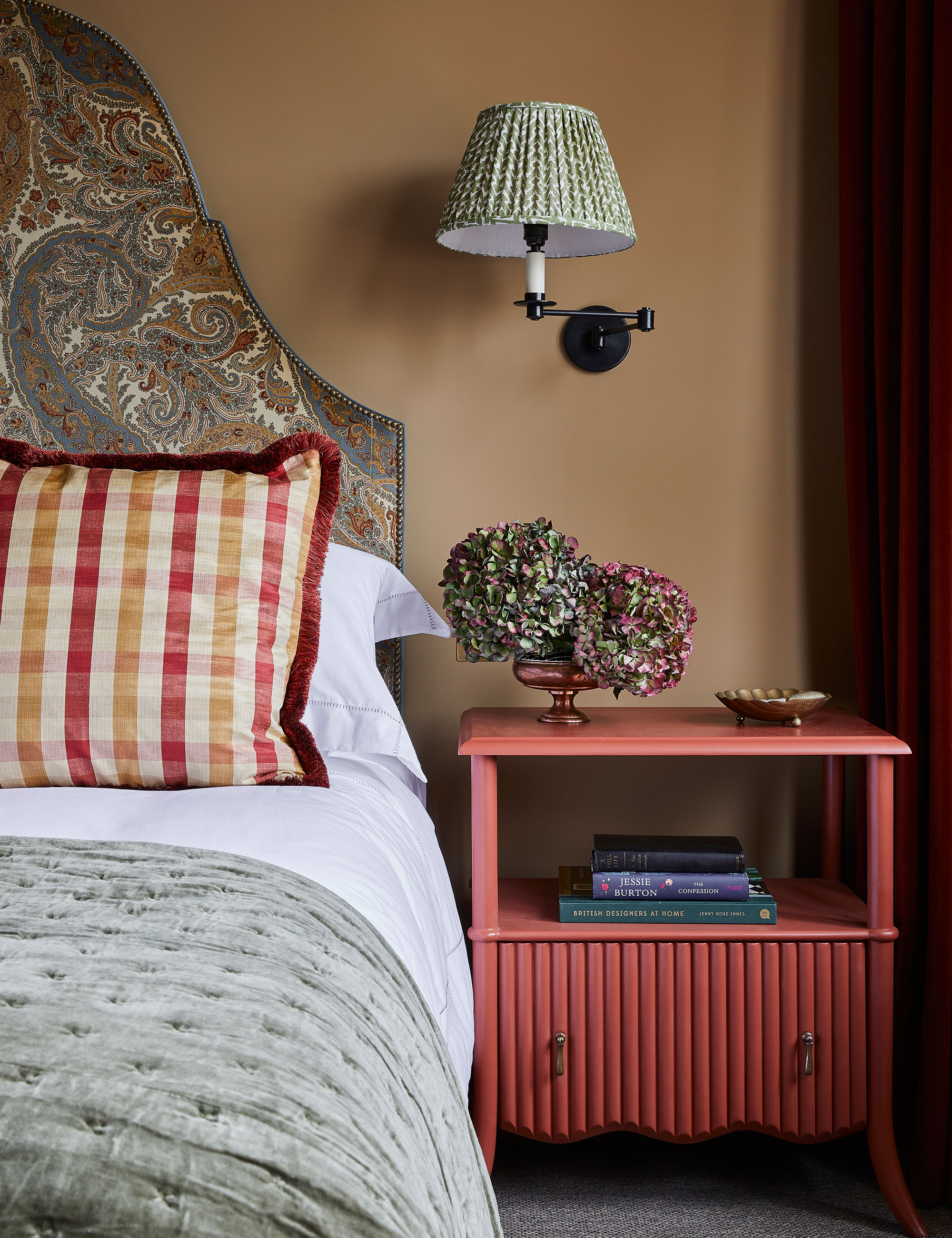12 cozy bedroom ideas designers swear by for a warm and inviting sleep retreat
The best cozy bedroom ideas to help you unwind, recharge, and wake up refreshed

Charlotte Olby

- 1. Stick to a warm, cocooning color palette
- 2. Up the cozy factor with wallpaper
- 3. Bring the outdoors in
- 4. Switch up your bed linen
- 5. Layer up your bed with a quilt
- 6. Pile on the pillows
- 7. Focus on the headboard
- 8. Roll out a rug
- 9. Try a canopy or nook bed
- 10. Create a hotel-style seating area
- 11. Throw in some florals and fragrance
- 12. Turn down the lights
A bedroom should be the most restful space in the home, yet all too often it becomes a catch-all for clutter, unfolded laundry, and gets neglected as a less 'public' space in the home.
Bedrooms are where we begin and end each day, so implementing some cozy bedroom ideas is about reclaiming this space for what it’s truly meant for – rest, relaxation, and comfort. Whether you’re working with a compact layout or a generous floor plan, the right design choices can turn your room into a cozy personal sanctuary that you long to retreat to at the end of a long day.
From thoughtful lighting schemes to plush bedding, soothing palettes, and natural materials, there are endless ways to make your bedroom feel cocooning. The expert tips ahead will show you how to combine style and practicality, so your bedroom feels both polished and perfectly snug.
1. Stick to a warm, cocooning color palette

Bedroom color ideas play one of the most important roles in creating a cozy bedroom. Deep, earthy shades and warm neutrals instantly set the tone, making the space feel enveloping and restful.
Color drenching a bedroom in a warm shade is one of the simplest ways to make it feel instantly more inviting. When the walls, furniture, and fabrics are tied together tonally, the room feels less fragmented and far more enveloping.
Monochromatic color schemes can also be incredibly effective. Greens, in particular, are well known for their calming yet cozy qualities. Opting for deeper tones rather than pale shades ensures the room feels cocooning rather than cold. Whether you embrace warm white, earthy terracottas, forest greens, or muted berry shades, the key is to create a tone that makes a bedroom feel warmer.
2. Up the cozy factor with wallpaper

Bedroom wallpaper is one of the easiest ways to transform a sleep space from plain to cozy.
Design expertise in your inbox – from inspiring decorating ideas and beautiful celebrity homes to practical gardening advice and shopping round-ups.
Whether you opt for bold pattern, subtle texture, or an all-over mural, wallpaper can instantly wrap a room in warmth. Unlike paint, it adds dimension and interest, creating a layered effect that makes even the simplest bedroom feel more inviting.
'Dark and neutral tones and layers with textures come into play this season for the bedroom – all shades of beige, deep olive green for that pop of color, and textured whites are in for fall,’ says Caitlin O’Keeffe, merchandise field manager at Serena & Lilly. ‘Wallpaper has also made a huge comeback, so don’t be afraid to use wallpaper with texture in the bedroom, such as grasscloth or fabric, to create a cozy sleeping oasis.’
For a truly inviting effect, extend the wallpaper across all four walls or even onto the ceiling – the result is a space that feels as stylish as it is snug.
Designer Sarah Sherman Samuel's new fall collection at Lulu and Georgia, Reverie, is filled with beautiful wallpapers, like the Garden Walk Paperweave and the Mermaid Toile that would be perfect for creating a cozier bedroom.
3. Bring the outdoors in

Echo the calming qualities of nature by incorporating earthy finishes, botanical motifs, and organic textures to instantly soften the space, making it feel more grounded and serene.
To welcome the outdoors in, the designers at Sims Hilditch have used a wealth of wood and weathered natural materials in this cozy bedroom seen above, with a floral upholstered headboard and a small vase on the nightstand.
As well as including floral room decor, according to color psychology, nature-inspired shades are also especially effective in cozy bedrooms. ‘When it comes to making a room feel cozy, natural materials in neutral tones are a great way of warming up a space and adding texture and, all importantly, character,’ says Tom Rutt, founder, TR Studio.
‘Think natural timber accents in the form of pieces of objet or small side tables; cushions in linen or bouclé; organic class or pottery vases; and adding in some greenery, such as a fiddle leaf or olive tree. Each of these, individually or together, can make a room feel welcoming and cozy without costing the earth.’
4. Switch up your bed linen

Nothing transforms a bedroom quite like well-chosen bed linen. By mixing patterns, textures, and finishes, your bed instantly becomes the centerpiece of a cozy scheme. Think ditsy florals, ruffles, or soft frills for a romantic touch, or pair crisp sheets with heavier quilts for a more tailored, layered look.
‘When it comes to the snuggle factor, we like to ramp it up to eleven, so double up your throws by layering different textures; velvet and linen are a great pairing,’ suggests Georgia Metcalfe, founder of French Bedroom. ‘Complement vintage patterned beds and cushions with nostalgic black and white photos of special moments.'
The key is to create a bed you want to sink into at the end of the day, so you want to make your sleep space look as well-dressed as those done by professionals, particularly when decorating a guest bedroom.
The Bed Threads 'build your own bundle' is an excellent way to create a pick n mix bundle of linens in a myriad of cozy hues, all in their signature flax linen.
5. Layer up your bed with a quilt

A new chunky throw blanket or quilt is one of the simplest yet most effective ways to make a bedroom feel cozy. Look to the patchwork trend for something truly nostalgic and pick up a folky quilt like the Chocolate Gingham Scalloped Quilt from The Six Bells.
More than just practical, quilts add texture, weight, and an inviting lived-in quality to the bed. Swapping out lightweight linens for heavier, tactile layers instantly signals comfort and warmth, making your bed feel like a true retreat.
Caitlin O’Keeffe suggests: ‘Achieving the ultimate cozy bedroom is all about simplicity. Swap out your summer whites and brights for gingham sheeting in earthier colors like green or brown. Layer a thick quilted coverlet and a cozy throw at the end of the bed for extra warmth.'
'Cozy decor is less about seasonal trends and more about creating an atmosphere that feels like a gentle embrace year-round and can be woven throughout the bedroom in subtle, thoughtful ways,' adds Nina Lichtenstein. 'Layered bedding with quilts and duvets, a woven stool for candles or books, a vase of fresh flowers or curtains that filter morning light, can transform a space from functional to deeply nurturing.'
6. Pile on the pillows

No bedscape is complete without throw pillows – they’re the finishing touch that makes a bed feel inviting and indulgent.
Layering different sizes and shapes creates depth and softness. It’s not just about looks either: the right combination of pillows adds physical comfort as well as visual warmth. Similarly to blankets, pick varying textures – think linen, velvet, and embroidered cotton – and try pattern mixing to enhance the layered, cozy effect.
Alternatively, Caitlin O'Keeffe suggests adopting the single pillow trend. 'Complete the look with an oversized lumbar pillow that’s almost as wide as the bed. Always invest in quality bedding for comfort and longevity.'
The Modern Silk Stripe Bolster Pillow in a warm buttery yellow and the Classic Cotton Velvet Bolster Pillow, both from West Elm, are perfect suggestions.
7. Focus on the headboard

The headboard you choose will set the tone of your bedroom, and opting for a statement style can help anchor the space. Choosing an oversized style adds an element of comfort, making the room feel instantly cozier. In smaller bedrooms, tall headboards have the added benefit of drawing the eye upward, helping to make a small bedroom look bigger.
In this Terrace Suite at Kit Kemp’s The Soho Hotel, seen above, the master bedroom features a hand-embroidered appliqué headboard created in collaboration with fashion designer Clio Peppiatt and inspired by the local Soho music scene.
For your own scheme, consider creating a headboard with your favourite fabric for a finish that feels personal. Designed by Shea McGee and available in 11 different patterns, this Ruffled Wall Mounted Headboard from her Threshold™ designed with Studio McGee line at Target is a great budget-friendly option.
8. Roll out a rug

Flooring often gets overlooked in bedroom design, but a rug is one of the most effective ways to add instant coziness. A soft surface underfoot not only makes the space feel warmer but also brings texture, pattern, and color into play.
'There are quite a few ingredients to work from when you’re creating a cozy bedroom, but I often like to choose a beautiful bedroom rug to lie down on timber floors and build up from there,' says interior designer Tamsin Johnson. 'When you’ve got the rug, you can pick up on a detail or color from that and pick a beautiful headboard (I often favor a boucle linen to offer a cool, neutral backdrop) and scatter cushions.'
For extra indulgence, think beyond standard floor coverings. 'There’s nothing cozier in a bedroom than a sheepskin rug, in my opinion,' says Bethany Adams. 'They’re great for layering over larger rugs and carpets, which can make a space feel extra cozy. I also love using them to highlight a certain area, like a comfortable chair for reading.'
Whether it’s a large statement rug, a runner by the bed, or a small sheepskin by a reading nook, rugs are an essential ingredient in the recipe for a warm and welcoming bedroom.
Joon Loloi's fall collection is filled with beautiful pieces, and both the Lone Fox collaboration and their line with beloved designer Heidi Caillier are worth checking out.
9. Try a canopy or nook bed

Few pieces of furniture create coziness quite like a canopy bed. With their enveloping drapes, canopy beds introduce a sense of intimacy, turning even large or lofty bedrooms into hotel-worthy sanctuaries.
'I like a bedroom to feel almost a little ‘temple-like’, which I think comes from a few qualities,' says Tamsin Johnson. 'I want my bedrooms to have a feeling of grandeur about them, while also needing to be a cozy sanctuary and projecting a sense of calm. I like them to feel a little ‘off-limits’ to everyone else – as if it is a privilege to enter the sanctum.'
For a similar sense of cocooning comfort in a smaller footprint, nook beds are another clever option. Built into alcoves or framed with joinery, they create an enclosed sleeping space that feels safe, tucked-away, and irresistibly cozy.
10. Create a hotel-style seating area

Just as in a boutique hotel, a well-placed armchair, desk, or unexpected banquette nook introduces a sense of indulgence and gives you a place to unwind outside of the bed itself.
Even in smaller spaces, a slim bench at the end of the bed or a cozy window seat can provide the same effect without overwhelming the bedroom layout.
'‘Something I always try to do in bedrooms is to create intimate spaces that feel personal – an antique bedside desk where you can pull out stationery and write a quick note; a comfortable sitting area,’ says Karen Pulaski, interior designer and owner of Tribute Goods in Houston, Texas. ‘Fresh flowers are a must,’ she adds.
Built-in banquettes are a particularly stylish option, as seen in a recent Shea McGee bedroom design. You can create something custom or try out the Jean Slipcovered Dining Banquette from Target.
11. Throw in some florals and fragrance

Sometimes it’s the smallest details that make the biggest difference when creating a cozy bedroom. Fresh flowers on the nightstand, a softly flickering candle, or a subtle room fragrance can instantly shift the atmosphere and make the space feel more personal.
‘Your bedroom should be your personal sanctuary. Add some simple extra touches, such as seasonal flowers, soft lighting, candles, and cushions, and create a room that feels like a hug every time you walk in,' adds Georgia Metcalfe.
Your nightstand is the perfect place to weave in these little luxuries. A favorite candle paired with a ceramic match striker, a small bud vase of seasonal blooms, or even a stylish carafe and glass for a hotel-inspired touch within arm’s reach.
12. Turn down the lights

Lighting is an important ingredient in a cozy bedroom recipe, so when you're planning bedroom lighting, it’s worth thinking beyond a single overhead pendant.
A layered scheme that mixes pendants, bedside lamps, and even small accent lights ensures you can adjust the mood depending on the time of day. Materials matter too.
‘Materials are just as important as style when choosing lighting for your home,’ says Charlie Bowles, director, Original BTC. ‘Bone china is an ideal choice, bringing a lovely softness of finish and a beautifully translucent glow. This soft light is ideal for creating a cozy atmosphere that makes you feel instantly comfortable and relaxed.’
‘Lighting can instantly transform and illuminate a room to create a comfy space,’ agrees Tanu Jandu, interior designer at Catherine Wilman Interiors. ‘This can be achieved by using different types of lighting, from focal pendants to dimmer lamps. Directional lighting can be used to enhance key furniture pieces by adding focal lighting.'
Shop cozy bedroom upgrades
How can I make my bedroom cozy on a budget?
If your question is how do I make my room cozy on a budget, you’ll be delighted to know that there are plenty of options that will make it warm and welcoming without the project costing much.
Coziness can come from the colors you select, the finishes you pick, the materials you introduce, and even the decorative accessories you display, and there are a whole host of ways to create the warming ambience you desire.
‘At its core, coziness is a feeling. A feeling of safety, warmth and comfort,’ says Yvonne Keal, senior product manager at Hillarys. Working with color, texture and lighting can make a room snug, and that needn’t involve a big spend. This is how to create a cozy room or cozy corner on a budget.'
There’s also a free-of-charge way to make a room cozy. ‘Display your belongings and keepsakes with love and pride; seeing things that remind you of a previous vacation or a market you once visited with a friend warms the heart and makes for a happy, cozy home,’ says interior designer Naomi Astley Clarke.

Jennifer is the Digital Editor at Homes & Gardens, bringing years of interiors experience across the US and UK. She has worked with leading publications, blending expertise in PR, marketing, social media, commercial strategy, and e-commerce. Jennifer has covered every corner of the home – curating projects from top interior designers, sourcing celebrity properties, reviewing appliances, and delivering timely news. Now, she channels her digital skills into shaping the world’s leading interiors website.
- Charlotte OlbyStyle & Trends Editor





